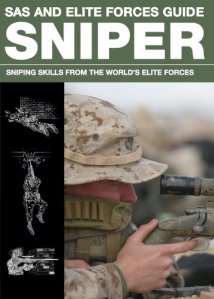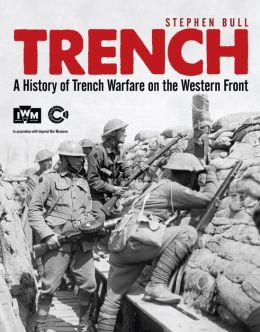 Sniper: Sniping Skills from the World’s Elite Forces, Martin J. Dougherty (Amber Books 2012)
Sniper: Sniping Skills from the World’s Elite Forces, Martin J. Dougherty (Amber Books 2012)
Variety is the spice of life. It’s also the spice of reading. I wouldn’t want to look at books like this regularly, but once in a while is good. Sniping, or shooting at long range from hiding, is an interesting topic in a number of ways: historically, strategically, psychologically, biologically, mathematically. And this book – subtitled an “SAS and Elite Forces Guide” to make it even more attractive to psychotics, psychopaths and spice-seekers – is a good introduction to the art of dealing death at a distance. It’s a well-designed mixture of line-drawings and uninspired but easy-to-read text:
As early as the 1770s, the term “sniper” was in use … although the context was different than today. The term originated in the sport of hunting small birds, of which the snipe was one of the hardest to hit. Thus a “sniper” was an extremely accomplished hunter who won the respect of his peers, and the term came to be applied in the same context as other words such as sharpshooter or marksman. (“Part One: The Sniper”, ch. 1, “A Brief History of Sniping”, pg. 18)
As he describes the development and techniques of sniping, Martin J. Dougherty also describes some famous snipers, like the Finn Simo Häyhä (1905-2002), nicknamed “The White Death” for the hundreds of casualties he inflicted when the Red Army invaded Finland at the beginning of the Second World War. Snipers are valuable not merely because they have a higher kill-ratio than an average soldier, but because their kills are often more harmful to the enemy: they try to target officers, radio-operators and other specialists. But a sniper’s most valuable target is often an enemy sniper, so snipers sometimes fight duels, like that between the Russian Vassili Zaitsev (1915-91) and (perhaps) a German called Major Erwin Koenig during the Battle of Stalingrad.
But sometimes enemy snipers are best left alone:
During the Vietnam War, US troops positioned near Da Nang came under fire at the same time every day by a particularly persistent enemy sniper who became known as Five O’Clock Charlie. Various attempts to eliminate the sniper having failed, the troops were in the process of moving a 106mm (4.17in) recoilless rifle up to the top of a hill when the realization came that this sniper had not actually managed to hit anyone. Rather than blast his suspected position with 106mm high-explosives, it was decided to leave him alone in case he was replaced by someone more competent. (“Part Three: Snipers in Action”, ch. 12, “The Effect of the Shot”, pg. 290)
So that sniper became funny rather than frightening, though I have to wonder whether his missed shots were deliberate rather than incompetent. Effective snipers are certainly frightening, so sniping becomes a branch of psychological warfare:
The ordinary soldier often has no way to respond … and this is a most demoralizing position to be in. Even in fairly low-threat areas there is always a suspicion that a sniper may, even now, be drawing a bead. … A lone sniper can hold up a large body of troops for some time. There have been cases of companies or even battalions halted for lengthy periods by a few shots. (“The Effect of the Shot”, pg. 291)
This fear means that capture is more dangerous for a sniper than for an ordinary soldier: “combat troops … have a special hatred for enemy snipers, especially if they have recently taken casualties from sniping” (“Part Three: Snipers in Action”, ch. 8, “The Sniper in the Field”, pg. 196). So a good sniper needs to be good at much more than shooting: he has to be able to move into position and fire without being seen. Camouflage and concealment are essential parts of a sniper’s training. But he needs to be able to improvise too: Simo Häyhä used to “hold snow in his mouth to prevent his breath condensing and giving away his position” (ch. 1, pg. 34).
In deserts, jungles or cities, different techniques are needed but some things don’t change: snipers always need patience, coolness and good judgment. This is where biology comes in: snipers are drawn disproportionately from certain races and sub-races. The book has an appendix listing “Top Snipers from the American Revolutionary War to the Present” and it’s no surprise to find Scottish and Irish surnames like Murphy, Ferguson, Hulme, Mawhinney and McGuire. Furthermore, ghillie suits, the camouflage outfits that mimic vegetation and break up the human outline, were invented in Scotland for stalking deer.
More exotic surnames might have been in the appendix if some races were less clannish and had fought larger wars:
Afghan tribesmen have managed to achieve a surprising degree of accuracy with home-made flintlock weapons called jezails. These weapons outranged the muskets of British infantry, and some remain in use today. (ch. 1, “A Brief History of Sniping”, pg. 19)
This book also talks a lot about rifles and, in the final section, about the ways bullets pulp flesh, shatter bone and destroy internal organs. Or not destroy them: Dougherty also discusses the economics of killing versus wounding. A dead soldier is often far less costly than a wounded one. Dead men don’t fight, but they don’t have to be cared for either.
Less grotesque and in some ways more interesting is the question of how bullets get to the target. Firing at long range is affected by things that soldiers firing at close range don’t have to take into account:
On a very long shot, wind calculations become highly complex. The strength and even the direction of the wind can vary over the distance covered by a long shot, and there may also be eddies around the corners of buildings and other objects. Air temperature and humidity also affect a shot by changing the amount of drag the air exerts on a bullet as it passes through. … A sniper needs to be able to estimate the aggregate effect of these many factors on his shot at the precise moment he squeezes the trigger. The only way to learn this is from experience. … All snipers are trained to estimate wind speed from the movement of vegetation or litter, and how this will affect a bullet in flight. Yet, even with all this knowledge, picking an aim-point is something of a “black art”, with some snipers being instinctively better at it than others, sometimes without really understanding why they can fit all the pieces together to make a perfect shot. (“Part Two: The Making of a Sniper”, ch. 6, “Marksmanship”, pg. 164)
It’s the black art of training white matter: of supplying the brain with repeated experiences and allowing it to form implicit rules from them. The speed and efficiency with which these rules are formed and then applied will be related to the intelligence of the sniper. It’s not a job for stupid men and other groups are excluded too: the reckless, on the one hand, and the squeamish, on the other. Snipers have to see and understand the effects of their bullets in a way ordinary soldiers don’t.
But brain-training and bullet-aiming are mathematical processes no less than ballistics and bone-shattering. Sniping itself is one of the variables fed into the vast calculus of war, which is part of the even bigger calculus of history. Good snipers must be worth much more than their weight in gold. But the Iraq war is discussed and illustrated in this book and prompts me to raise a dangerous idea. The most cost-effective use of American or British snipers in recent history might have been to shoot neo-conservatives rather than Iraqi insurgents or members of the Taliban. One bullet, one Bush, Blair or Obama?
Alas, if you like the sound of that, then monitoring-devices hidden in this review have already beamed your details to all relevant agencies and a drone is speeding on its way. Sniping is centuries old now, drones are much more recent. But both are expressions of a very old phenomenon: war. Thanks in part to the neo-conservatives, who like mass immigration as much as their liberal opponents do, that phenomenon may return to Europe and America. If so, sniping will come with it and books like this will become more than spice in a diet of reading.
Read Full Post »
 Trench: A History of Trench Warfare on the Western Front, Stephen Bull (Osprey Publishing 2010)
Trench: A History of Trench Warfare on the Western Front, Stephen Bull (Osprey Publishing 2010)

